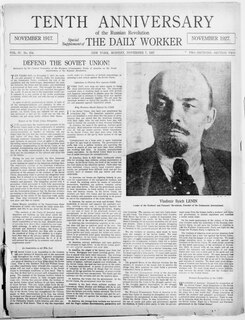
The Communist Party USA, officially the Communist Party of the United States of America (CPUSA), is a communist party in the United States which was established in 1919 after a split in the Socialist Party of America following the Russian Revolution.

John "Johnny" Gates, born Solomon Regenstreif was an American Communist business man, best remembered as one of the individuals spearheading a failed attempt at liberalization of the Communist Party USA in 1957.

The Daily Worker was a newspaper published in New York City by the Communist Party USA, a formerly Comintern-affiliated organization. Publication began in 1924. While it generally reflected the prevailing views of the party, attempts were made to reflect a broader spectrum of left-wing opinion. At its peak, the newspaper achieved a circulation of 35,000. Contributors to its pages included Robert Minor and Fred Ellis (cartoonists), Lester Rodney, David Karr, Richard Wright, John L. Spivak, Peter Fryer, Woody Guthrie and Louis F. Budenz.

William Z. Foster was a radical American labor organizer and Communist politician, whose career included serving as General Secretary of the Communist Party USA from 1945 to 1957. He was previously a member of the Socialist Party of America and the Industrial Workers of the World, leading the drive to organize the packinghouse industry during World War I and the steel strike of 1919.

Earl Russell Browder was an American politician, communist activist and leader of the Communist Party USA (CPUSA). Browder was the General Secretary of the CPUSA during the 1930s and first half of the 1940s.

Harrison George was a senior Communist Party of the United States (CPUSA) leader. He is best remembered as the editor of the official organ of the Profintern's Pan-Pacific Trade Union Secretariat (PPTUS) as well as the party's West Coast newspaper, People's World.

Max Bedacht Sr. was a German-born American revolutionary socialist political activist, journalist, and functionary who helped establish the Communist Party of America. Bedacht is best remembered as the long-time head of the International Workers Order, a Communist Party-sponsored fraternal benefit organization.
The Industrial Pioneer was a monthly publication of the Industrial Workers of the World (IWW). It was published in Chicago by the general executive board of the IWW from 1921 to 1926, under various editors. The precursor of the Industrial Pioneer was the One Big Union Monthly. The editor of One Big Union Monthly, John Sandgren, used his position to wage war on the Communists in the IWW. When his editorials became too sectarian, the IWW replaced him as editor in 1931, and changed the name of the publication to the Industrial Pioneer. The new editor was a Communist, however, and this alienated the non-Communist majority of IWW members. He was removed as editor in 1922.

During the ten decades since its establishment in 1919, the Communist Party USA produced or inspired a vast array of newspapers and magazines in the English language.
Clarence A. "Charlie" Hathaway was an activist in the Minnesota trade union movement and a prominent leader of the Communist Party of the United States from the 1920s through the early 1940s. He is best remembered as the party's leading organizer of the Federated Farmer-Labor Party in 1923 and 1924, as the editor of The Daily Worker (1933–1940), and as a longtime member of the Communist Party's governing Central Committee. He was also a longtime informant for the FBI.
The New York Workers School, colloquially known as "Workers School," was an ideological training center of the Communist Party USA (CPUSA) established in New York City for adult education in October 1923. For more than two decades the facility played an important role in the teaching of party doctrine to the organization's functionaries, as well as offering a more general educational program to trade union activists.

The Smith Act trials of Communist Party leaders in New York City from 1949 to 1958 were the result of US federal government prosecutions in the postwar period and during the Cold War between the Soviet Union and the United States. Leaders of the Communist Party of the United States (CPUSA) were accused of violating the Smith Act, a statute that prohibited advocating violent overthrow of the government. The defendants argued that they advocated a peaceful transition to socialism, and that the First Amendment's guarantee of freedom of speech and of association protected their membership in a political party. Appeals from these trials reached the US Supreme Court, which ruled on issues in Dennis v. United States (1951) and Yates v. United States (1957).
Ida Mary Inman (1894–1985), known as Mary Inman, was an American political activist and writer. Inman is best known for her 1940 book, In Woman's Defense, which was a pioneering effort to legitimize the domestic labor associated with homemaking as worthy and respectable field of human endeavor.
Sender Garlin was an American journalist pamphleteer, and writer.

James Patrick Cannon was an American Trotskyist and a leader of the Socialist Workers Party.
Harry Freeman was a 20th-Century American journalist, best known for serving in the New York bureau of TASS. The magazine editor Joseph Freeman was his brother.
The San Francisco Workers' School was an ideological training center of the Communist Party USA (CPUSA) established in San Francisco for adult education in 1934. "It was a typical specimen of a Communist school, such as would come under investigation by federal and state authorities for decades afterward.". in the 1940, it emerged as the California Labor School.
Charles Dirba was a Latvian-American co-founder of the Communist Party of America (CPA) and Communist Party USA (CPUSA).
Marine Workers Industrial Union (MWIU) was as short-lived union (1930-1935), initiated by the Communist Party of the USA (CPUSA).
Roy Hudson, also known as Roy B. Hudson, served on the national executive board of the Communist Party USA and national trade union director and trade union expert.










